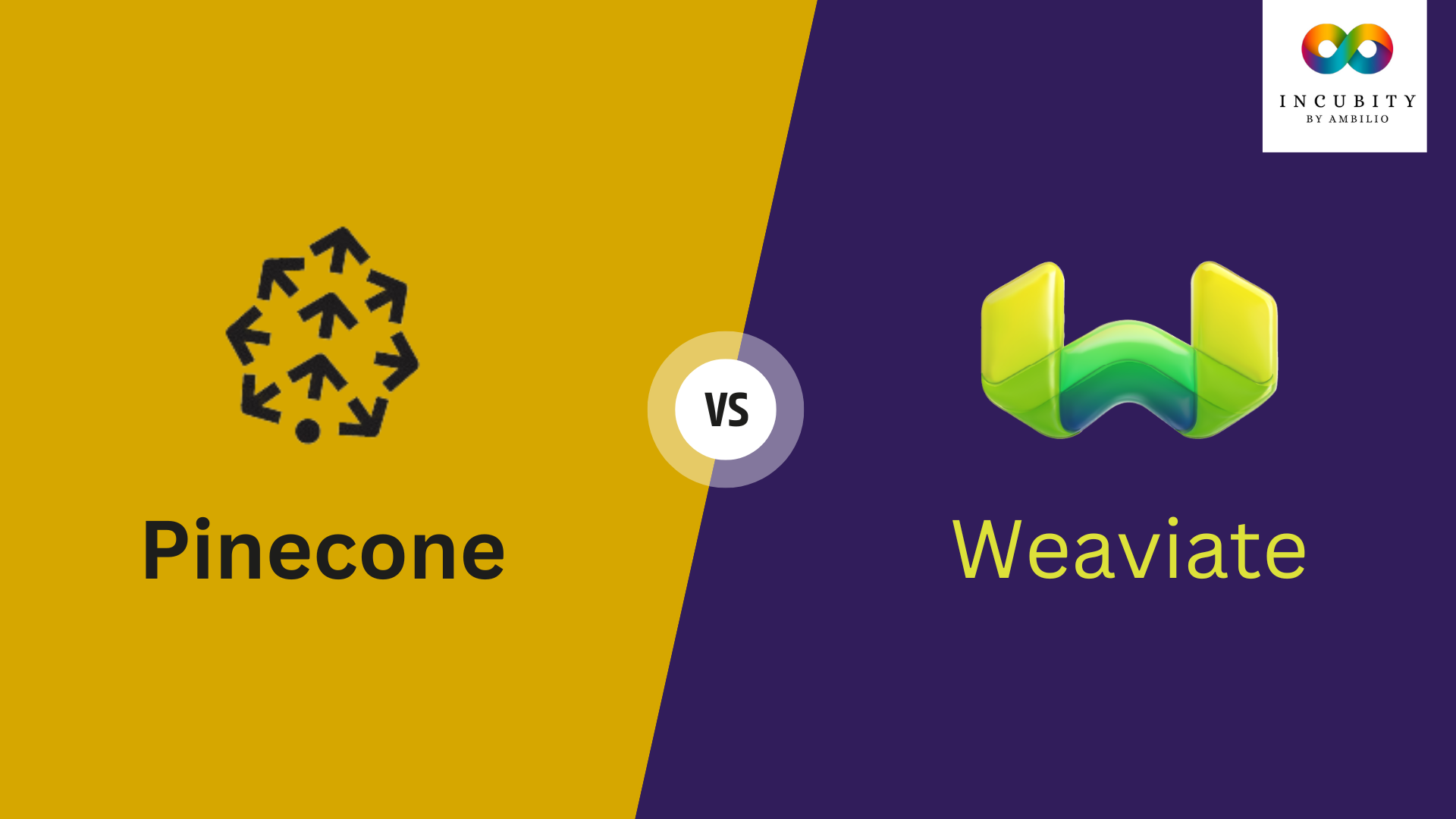Generative AI and Large Language Models (LLMs) have revolutionized various industries by enabling machines to understand and generate human-like content. At the heart of these advancements lie vector databases, which are essential for storing and manipulating high-dimensional data representations. These databases provide the foundation for complex AI algorithms to analyze relationships between data points, make predictions, and generate coherent outputs. In this article, we delve into the detailed comparison of two leading vector databases, Pinecone vs Weaviate, exploring their features, capabilities, and potential applications in the context of Generative AI and LLMs.
Understanding Pinecone
Pinecone is a state-of-the-art vector database designed to handle high-dimensional data efficiently. Developed by Pinecone Systems Inc., Pinecone offers a robust solution for storing, retrieving, and manipulating vector representations of data. Its primary focus is on providing fast and accurate search capabilities across diverse datasets, making it an invaluable tool for applications in artificial intelligence, machine learning, and data analytics.
Key features of Pinecone include:
- Versatility: Pinecone is renowned for its versatility in handling various data types, including images, audio, text, and numerical data. It can efficiently process a wide range of data formats, making it suitable for diverse applications such as multimedia content recommendation, natural language processing, and IoT analytics.
- Scalability: Pinecone is built to scale, allowing it to handle large-scale datasets with millions or even billions of vectors. Its architecture is optimized for high throughput and low latency, ensuring efficient search and retrieval operations even with massive amounts of data.
- Performance: Pinecone boasts exceptional speed and accuracy in processing high-dimensional data queries. Its advanced indexing and retrieval algorithms enable it to deliver fast and precise search results, making it ideal for real-time applications that require rapid data processing.
- Hybrid Search Capabilities: Pinecone recently introduced hybrid search capabilities, combining traditional search methods with advanced AI algorithms. This allows users to achieve enhanced search results by leveraging both structured and unstructured data, improving the relevance and accuracy of search queries.
- Namespaced Data Support: Pinecone offers robust support for namespaced data, enhancing data organization and retrieval processes. This feature is particularly beneficial for large-scale applications requiring structured data handling, allowing users to efficiently manage and query complex datasets.
Overall, Pinecone stands out as a versatile and high-performance vector database, catering to the needs of organizations seeking efficient solutions for storing, retrieving, and analyzing high-dimensional data. Its flexibility, scalability, and speed make it a valuable tool for advancing AI-driven applications and driving innovation across various industries.
Exploring Weaviate
Weaviate is an advanced open-source vector database designed to handle high-dimensional data with a focus on scalability, flexibility, and natural language processing (NLP). Developed by SeMI Technologies, Weaviate provides a powerful solution for storing, retrieving, and analyzing vector representations of data, making it particularly well-suited for applications in artificial intelligence, machine learning, and data-driven decision-making.
Key features of Weaviate include:
- Natural Language Processing (NLP) Capabilities: Weaviate is specialized in processing natural language data, leveraging contextualized embeddings to deliver precise results tailored to linguistic analyses. This makes it ideal for tasks such as text classification, sentiment analysis, entity recognition, and semantic search.
- Scalability and Flexibility: Weaviate is built to scale, allowing it to handle large volumes of data efficiently. Its architecture is designed to support billions of data objects and vector embeddings, making it suitable for applications with growing datasets and high throughput requirements.
- AI-Native Functionality: Weaviate simplifies the integration of advanced machine learning models within applications, enhancing their cognitive capabilities. It provides seamless integration with popular machine learning frameworks and libraries, enabling developers to leverage state-of-the-art algorithms for tasks such as recommendation systems, personalized content delivery, and predictive analytics.
- Security and Replication: Weaviate prioritizes security and replication for production readiness. It offers robust security features to protect data privacy and integrity, as well as replication mechanisms to ensure data availability and reliability in distributed environments.
- API Support: Weaviate provides well-documented APIs, including both REST and GraphQL, allowing developers to interact with the database and perform complex searches, queries, and updates with a high degree of flexibility and customization. This enables seamless integration with existing applications and workflows, facilitating the development of AI-driven solutions.
Overall, Weaviate is a versatile and scalable vector database solution, tailored for organizations seeking efficient and flexible solutions for processing high-dimensional data, particularly in the context of natural language processing and AI-driven applications. Its focus on scalability, flexibility, and security makes it a valuable tool for driving innovation and advancing data-driven decision-making across various industries.
Pinecone Vs Weaviate
| Key Factors | Pinecone | Weaviate |
|---|---|---|
| Data Types | Wide range, including images, audio, sensor | Specialized for natural language, numerical data, JSON, CSV, RDF |
| Specialization | General-purpose vector search engine | Specialized for linguistic and numeric analyses, contextualized embeddings |
| Performance | Exceptional speed, millions of queries/sec | Quick search, ten nearest neighbors in milliseconds, highly scalable |
| Pricing | Commercial product, subscription-based | Open-source, licensed under Apache License 2.0, free to use and modify |
| API Support | Hybrid search capabilities, robust data org. | Well-documented APIs, REST and GraphQL support, high flexibility |
| Scalability | Scalable and efficient, versatile | Highly scalable, replication, security-focused, optimized for specific data types |
| User Satisfaction | Positive reviews, reliable performance | Positive user feedback, seamless integration with machine learning workflows |
| Use Cases | Diverse datasets, large-scale applications | Natural language processing, knowledge graph creation, recommendation systems |
Pinecone Vs Weaviate: Where to use which?
Here are some specific applications where Pinecone or Weaviate may be better suited:
Applications where Pinecone may be better:
- Large-scale, high-throughput search applications: Pinecone is optimized for handling millions of queries per second with exceptional efficiency, making it a robust choice for applications requiring rapid, high-volume search capabilities.
- Diverse data processing: Pinecone is a more general-purpose vector search engine that can handle a wide range of data types, including images, audio, and sensor data. This versatility makes it a good fit for applications dealing with diverse datasets.
- Comprehensive data storage and retrieval: Pinecone’s support for namespaced data and its adaptability to different data formats position it well for applications that require structured, organized data management at scale.
Applications where Weaviate may be better:
- Natural language processing: Weaviate is specialized for natural language data processing, leveraging contextualized embeddings to deliver precise results tailored to linguistic analyses. This makes it a suitable choice for applications focused on text-based data processing.
- Numerical data analysis: Weaviate’s focus on numerical data processing and its ability to perform intricate numeric computations make it a good fit for applications that require advanced analytics on numerical datasets.
- Knowledge graph creation: Weaviate’s capabilities in handling JSON, CSV, and RDF data sources, combined with its AI-native functionality, position it well for applications involved in building and maintaining knowledge graphs.
- Recommendation systems: Weaviate’s strengths in natural language and numerical data processing can be beneficial for applications that require advanced recommendation algorithms, such as content recommendation or product recommendation.
In summary, Pinecone is better suited for large-scale, high-throughput search applications with diverse data types, while Weaviate excels in natural language processing, numerical data analysis, knowledge graph creation, and recommendation systems that require specialized data processing capabilities.
Final Words
In conclusion, Pinecone vs Weaviate represent two leading vector database solutions, each offering unique features and capabilities tailored to different data processing requirements. By understanding the strengths and differences between these platforms, organizations can make informed decisions to advance their Generative AI and LLM initiatives, unlocking new possibilities for innovation and growth in the AI landscape. Whether it’s leveraging Pinecone’s versatility or harnessing Weaviate’s specialization, these vector databases pave the way for transformative AI applications across various industries.



